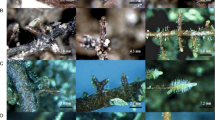Summary
The different methods used for synthesizing ectomycorrhizae since Melin's first experiments were reviewed and evaluated. A non-aseptic growth pouch method was proposed that allowed for the formation of ectomycorrhizae on several species of Pinaceae and of actinorhizal and non-actinorhizal angiosperms including woody cuttings. More than 30 fungal species thus tested formed ectomycorrhizae. In most cases full ectomycorrhiza formation required 3–10 days after inoculation. The method allowed for chronosequential destructive (fixation) and non-destructive (photography) observations. It was particularly useful for the description of extramatrical phase development including hyphal strands, sclerotia and fruit body primordia formation.
Similar content being viewed by others
References
Melin E 1922 Untersuchungen über die Larix-Mykorrhiza. I. Synthese der Mykorrhiza in Reinkultur. Svensk Bot. Tidskr. 16, 161–196.
Hacskaylo E 1953 Pure culture synthesis of pine mycorrhizae in terralite. Mycologia 45, 971–975.
Trappe J M 1962. Fungus associates of ectotrophic mycorrhizae. Bot. Rev. 28, 538–606.
Melin E and Nilsson H 1950 Transfer of radioactive phosphorus to pine seedlings by means of mycorrhizal hyphae. Physiol. Plant. 3, 88–92
Marx D H and Zak B 1965 Effect of pH on mycorrhizal formation of slash pine in asepticulture. For. Sci. 11, 66–75.
Richard C and Fortin J A 1970 Les mycorhizes duPicea mariana (Mill.) BSP.: Aspects morphologiques, anatomiques et systématiques. Nat. Can. 97, 163–173.
Richard C and Fortin J A 1975 Rôle protecteur duSuillus granulatus contre leMycelium radicis atrovirens sur des semis duPinus resinosa. Can. J. For. Res. 5 452–456.
Trappe J M 1962Cenococcum graniforme, its distribution, ecology, mycorrhiza formation, and inherent variation. Ph.D. Diss. Univ. Washington, Seattle. USA 148 p.
Pachlewska J 1968 Investigations on mycorrhizal symbiosis ofPinus sylvestris in pure culture on agar. Prace Inst. Badaw. Lesn. 345, 3–76.
Pachlewski R and Pachlewska J 1974 Studies on symbiotic properties of mycorrhizal fungi of pine (Pinus sylvestris L.) with the aid of the method of mycorrhizal synthesis in pure cultures on agar. Forest Research Institute, Warsaw, 228 p.
Mason P A 1975 The genetics of mycorrhizal associations betweenAmanita muscaria andBetula verrucosa. The Development and Function of Roots. Eds. J G Torrey and D T Clarkson. Academic Press, New-York and London, pp 567–574.
Mason P A 1980 Aseptic synthesis of sheathing ectomycorrhizas.In Tissue Culture Methods for Plant Pathologists. Eds. D S Ingram and J P Helgeson. Blackwell Scientific publications, Oxford, London, Edinburgh Boston Melbourne, pp 173–178.
Giltrap N J 1979 Experimental studies on the establishment and stability of ectomycorrhizas. Ph. D. Thesis. Univ. of Sheffield, UK 196 p.
Sohn R F 1981Pisolithus tinctorius forms long ectomy corrhiza and alters root development in seedlings ofPinus resinosa. Can. J. Bot. 59, 2129–2134.
Bigg W L and Alexander I J 1981 A culture unit for the study of nutrient uptake by intact mycorrhizal plants under aseptic conditions. Soil. Biol. Biochem. 13, 77–78.
Nylund J E 1981 The formation of ectomycorrhiza in conifers: Structural and physiological studies with special reference to the mycobiont,Piloderme bicolor. Ph.D. Thesis, Univ. Uppsala, Sweden, 34 p.
Skinner M F and Bowen G D 1974 The uptake and translocation of phosphate by mycelial strands on pine mycorrhizas. Soil Biol. Biochem. 6, 53–56.
Skinner M F and Bowen G D 1974 The penetration of soil by mycelial strands of ectomycorrhizal fungi. Soil Biol. Biochem. 6, 56–61.
Fortin J A 1965 Synthesis of mycorrhizae on explants of the root-hypocotyl ofPinus sylvestris L. Can. J. Bot. 44, 1087–1092.
Fortin JA and Piché Y 1979 Cultivation ofPinus strobus root-hypocotyl explants for synthesis of ectomycorrhizae. New Phytol. 83, 109–119.
Blakeslee G M 1977 Communication presented during a special session. Third North American Conference on Mycorrhizae.
Mullette K J 1976 Studies of Eucalypt Mycorrhizas. I. A Method of mycorrhiza induction inEucalyptus gummifera (Gaertn. and Hochr.) byPisolithus tinctorius (Pers.)Coker and Couch. Aust. J. Bot. 24, 193–200.
Lalonde M 1979 Techniques and observations of the nitrogen-fixing Alnus root nodule symbiosis.In Recent Advances in Biological Nitrogen Fixation. Ed. N. S. Subba Rao Oxford and I. B. H. Publication, New-Delhi, pp 421–434.
Fortin J A, Piché Y and Lalonde M 1980 Technique for the observation of early morphological changes during ectomycorrhiza formation. Can. J. Bot. 58, 361–365.
Piché Y and Fortin J A 1982 Development of mycorrhizae, extramatrical mycelium and sclerotia onPinus strobus seedlings. New Phytol. 91, 211–220.
Hewitt E J 1966 Sand and Water Culture Methods used in the Study of Plant Nutrition. Tech. Comm. 22 (2nd edition revised). Commonwealth Agricultural Bureaux, London, 431 p.
Normand P and Lalonde M 1982 Evaluation of Frankia strains isolated from provenances of twoAlnus species. Can. J. Microbiol. (In press).
Warrington S J, Black H D and Coons L B 1981 Entry ofPisolithus tinctorius hyphae intoPinus taeda roots. Can. J. Bot, 59, 2135–2139.
Dominik T 1969 Key to ectotrophic mycorrhizae. Folia For. Pol. Ser. A. 15, 309–328.
Zak B 1973. Classification of ectomycorrhizae.In ectomycorrhizae. Eds. G C Marks and T T Kozlowski. Academic Press, New-York, pp 43–78.
Piché Y, Fortin J A and Lafontaine J G 1981 Cytoplasmic phenols and polysaccharides in ectomycorrhizal and non-mycorrhizal short roots of pine. New Phytol. 88, 695–703.
Molina R 1981 Ectomycorrhizal specificity in the genus Alnus. Can. J. Bot. 59, 325–334.
Gaie W and Heinemann P 1980 Mycorhization du genreBetula parPisolithus arhizus, en conditions axéniques. Bull. Jard. Bot. Nat. Belg. 50, 375–383.
Marx D H and Ross E W 1970 Aseptic synthesis of ectomycorrhizae onPinus Taeda by basisdiopores ofThelephora terrestris. Can J. Bot. 48, 197–198.
Author information
Authors and Affiliations
Rights and permissions
About this article
Cite this article
Fortin, J.A., Piché, Y. & Godbout, C. Methods for synthesizing ectomycorrhizas and their effect on mycorrhizal development. Plant Soil 71, 275–284 (1983). https://doi.org/10.1007/BF02182663
Issue Date:
DOI: https://doi.org/10.1007/BF02182663




